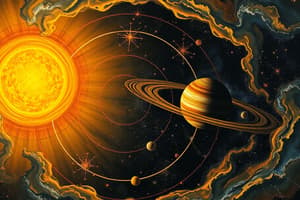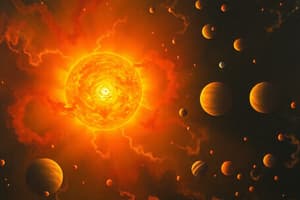Podcast
Questions and Answers
Which explanation of the solar system best fits the observations of the planets and how they orbit the sun?
Which explanation of the solar system best fits the observations of the planets and how they orbit the sun?
- The planets were formed by random collisions in space.
- The planets were formed separately and later captured by the sun.
- The sun and planets formed from a collapsing spinning cloud of gas and dust. (correct)
- The planets were created by a series of large explosions.
What is formed from leftovers in the solar system?
What is formed from leftovers in the solar system?
comet
Which scientist determined that the farther a planet is from the sun, the longer it takes to orbit the sun?
Which scientist determined that the farther a planet is from the sun, the longer it takes to orbit the sun?
Kepler
What object is made of frozen gas, ice, and dust that orbits in the outermost reaches of the solar system?
What object is made of frozen gas, ice, and dust that orbits in the outermost reaches of the solar system?
What is true for both gas planets and terrestrial planets?
What is true for both gas planets and terrestrial planets?
Which of the following has the highest energy?
Which of the following has the highest energy?
Which feature indicated a period of heavy bombardment followed by a period of low bombardment in our solar system?
Which feature indicated a period of heavy bombardment followed by a period of low bombardment in our solar system?
Which path is the correct path of light through a reflecting telescope?
Which path is the correct path of light through a reflecting telescope?
When a sunlike star's hydrogen runs out, at first it expands into __________.
When a sunlike star's hydrogen runs out, at first it expands into __________.
Which type of radiation would you look for in a star to demonstrate that nuclear fusion was occurring inside?
Which type of radiation would you look for in a star to demonstrate that nuclear fusion was occurring inside?
Which classification describes the Milky Way?
Which classification describes the Milky Way?
Which object would best be identified by a periodic Doppler shift in a star's spectrum along with a dip in the star's light intensity?
Which object would best be identified by a periodic Doppler shift in a star's spectrum along with a dip in the star's light intensity?
How do scientists know that the universe is expanding?
How do scientists know that the universe is expanding?
At what position of the earth in its orbit is it summertime in the Northern Hemisphere?
At what position of the earth in its orbit is it summertime in the Northern Hemisphere?
What planet is the closest to the sun?
What planet is the closest to the sun?
Mercury's high density suggests what?
Mercury's high density suggests what?
What planet has no moons?
What planet has no moons?
What planet is the brightest?
What planet is the brightest?
How does Venus rotate?
How does Venus rotate?
What planet gives us reasons to suggest it was tectonically active 3 billion years ago?
What planet gives us reasons to suggest it was tectonically active 3 billion years ago?
There is reason to believe there is what on Mars?
There is reason to believe there is what on Mars?
What 2 planets have similar atmospheres?
What 2 planets have similar atmospheres?
What planets are the inner planets?
What planets are the inner planets?
What planet is 98% of the mass of all the planets in the solar system?
What planet is 98% of the mass of all the planets in the solar system?
Name the characteristics of the outer planets?
Name the characteristics of the outer planets?
What planet has a big red spot?
What planet has a big red spot?
What is the largest planet?
What is the largest planet?
What planet has a different rotational axis than the rest of the planets?
What planet has a different rotational axis than the rest of the planets?
Which planet spins on its side?
Which planet spins on its side?
Which planet has very tiny rings?
Which planet has very tiny rings?
What planet was predicted before it was discovered?
What planet was predicted before it was discovered?
Where does Neptune's blue color come from?
Where does Neptune's blue color come from?
From Earth we always see the same side of the moon?
From Earth we always see the same side of the moon?
Name the 2 kinds of terrain found on the moon?
Name the 2 kinds of terrain found on the moon?
Remains of ancient lava flow is what?
Remains of ancient lava flow is what?
Flashcards are hidden until you start studying
Study Notes
Solar System Formation and Objects
- The solar system formed from a collapsing spinning cloud of gas and dust.
- Comets are formed from leftover materials in the solar system.
- Kuiper Belt objects consist of frozen gas, ice, and dust located in the outer reaches of the solar system.
Planetary Characteristics
- Both gas planets and terrestrial planets have a round shape.
- Mercury is the closest planet to the sun and has a large nickel-iron core suggested by its high density.
- Venus has no moons and is the brightest planet, rotating clockwise.
- Mars shows evidence of tectonic activity from 3 billion years ago and is believed to have ice.
Outer Planets
- Jupiter accounts for 98% of the total mass of all planets in the solar system; it features a prominent Great Red Spot.
- Saturn is the largest planet and has a unique rotational axis compared to other planets, along with its rings.
- Uranus spins on its side and has very tiny rings, while both Uranus and Neptune's atmospheres have similarities.
- Neptune's blue color is due to methane gas present in its atmosphere, and it was predicted before its discovery.
Astronomical Phenomena
- Gamma rays are the type of radiation to look for to demonstrate nuclear fusion in stars.
- The expanding universe is evidenced by galaxies moving away from each other, along with decreasing temperatures.
Lunar and Celestial Features
- The low crater density of the lunar maria indicates a period of heavy bombardment followed by low bombardment.
- The moon shows consistent visible features from Earth, which is why we observe the same side always.
- Moon's terrain includes highlands and lowlands, with ancient lava flow remnants referred to as sinuous rilles.
Observational Astronomy
- The light path in a reflecting telescope is: primary mirror → secondary mirror → eyepiece → eye.
- A periodic Doppler shift in a star's spectrum, alongside dips in light intensity, indicates the presence of a planet.
Earth’s Orbit
- The Northern Hemisphere experiences summer when Earth is at Position 1 in its orbit.
Studying That Suits You
Use AI to generate personalized quizzes and flashcards to suit your learning preferences.




